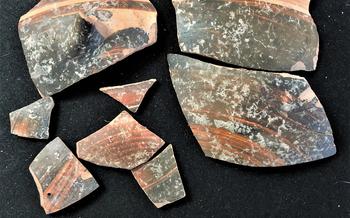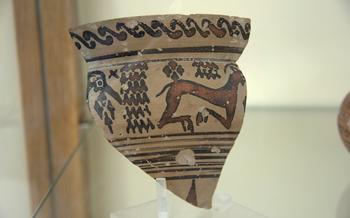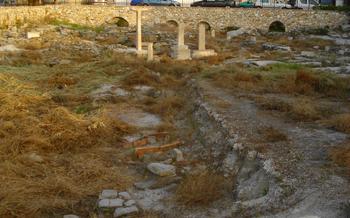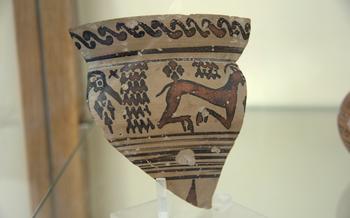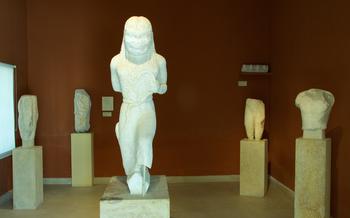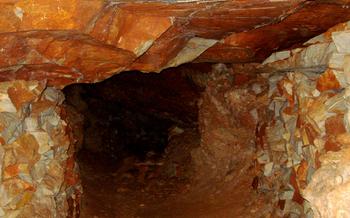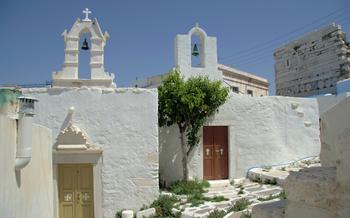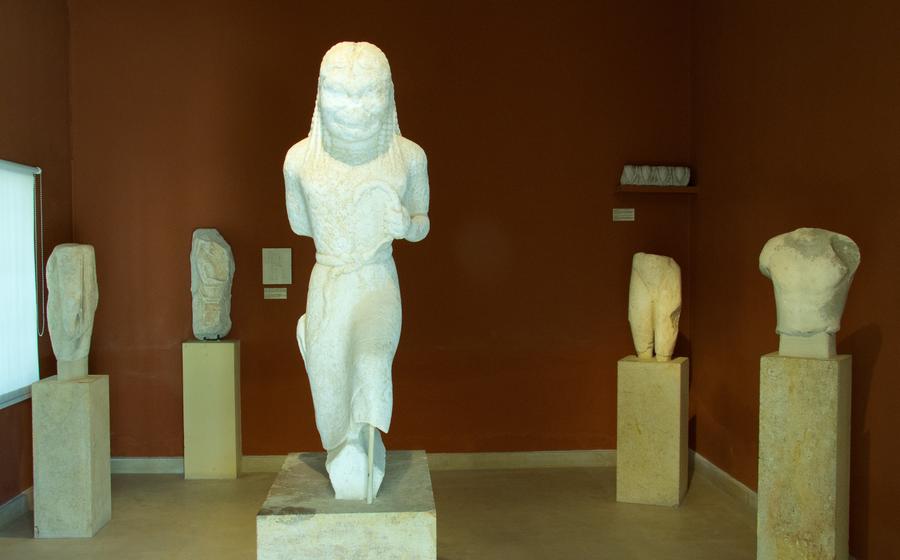
Paros Archaeological Museum
- Location and Accessibility
- Exhibitions and Displays
- Marble Sculptures
- Interactive Exhibits
- Temporary Exhibitions
- Guided Tours
- Audio Guides
- Educational Programs
- Research Facilities
- Museum Shop
- Accessibility
- Nearby Attractions
- Insider Tip:
Location and Accessibility
The Paros Archaeological Museum is conveniently situated in the heart of Parikia, the island's main town. It is just a short stroll away from the picturesque harbor, making it easily accessible for visitors arriving by ferry or boat. From the port, head towards the town center and follow the main road, Ethnikis Antistaseos Street. Turn left onto Agiou Nikolaou Street, and you will find the museum on your right. The museum's central location allows visitors to seamlessly integrate their visit with other sightseeing and exploration activities in Parikia.
Exhibitions and Displays
The Paros Archaeological Museum houses a rich collection of artifacts that provide a comprehensive overview of the island's history, culture, and archaeology. The exhibits are arranged in chronological order, beginning with the Neolithic period and continuing through the Byzantine era.
Among the highlights of the collection are a number of marble sculptures, including a headless statue of a kouros (a young man) from the 6th century BC, a relief depicting a seated goddess from the 5th century BC, and a fragment of a Roman sarcophagus from the 2nd century AD. The museum also displays a variety of pottery, tools, weapons, and jewelry from different periods of Paros's history.
One of the most notable pieces in the collection is the Parian Chronicle, a marble slab inscribed with a list of the winners of the Panhellenic Games from 776 BC to 264 BC. The chronicle is an invaluable source of information on the history of the ancient Greek world.
Marble Sculptures
Paros's rich marble deposits have played a pivotal role in shaping its history and identity. The island was renowned throughout antiquity for its exceptional white marble, considered one of the finest in the Mediterranean. Parian sculptors, utilizing this exquisite material, created masterpieces that continue to captivate the world.
The Paros Archaeological Museum houses a remarkable collection of marble sculptures, showcasing the virtuosity and artistry of ancient Parian sculptors. Among the highlights is the famous "Nike of Paros," a graceful statue of the goddess of victory, dating back to the 4th century BC. The intricate details and flowing drapery of this sculpture exemplify the skill and precision of Parian craftsmen.
Another notable piece is the "Kouros of Paros," an impressive life-size statue of a young man, dating to the 6th century BC. This kouros, with its serene expression and idealized proportions, represents the early stages of Greek sculpture and offers a glimpse into the development of the classical style.
The museum also exhibits numerous fragments and architectural elements from ancient temples and buildings, showcasing the decorative and structural applications of Parian marble. These artifacts provide valuable insights into the architectural history and urban landscape of ancient Paros.
Exploring the marble sculptures at the Paros Archaeological Museum is a journey through time, allowing visitors to appreciate the artistry and craftsmanship of ancient Greece, while gaining a deeper understanding of Paros's significant role in the realm of sculpture and the history of art.
Interactive Exhibits
The Paros Archaeological Museum takes visitor engagement to the next level with its interactive and multimedia exhibits. Interactive displays bring Paros's history and culture to life, making the museum experience both educational and enjoyable.
For instance, visitors can engage in a virtual tour of ancient Paros, exploring significant landmarks and sites through a 3D simulation. Another exhibit allows visitors to handle replicas of ancient artifacts, providing a tactile experience that deepens their understanding of the island's past.
The museum also features multimedia presentations that showcase the techniques and styles used by ancient Parian sculptors. These presentations offer a fascinating glimpse into the artistic process and the evolution of Paros's renowned marble sculptures.
With its interactive exhibits, the Paros Archaeological Museum offers a dynamic and engaging experience that caters to visitors of all ages, making it a must-visit destination for anyone interested in the rich history and culture of this beautiful island.
Temporary Exhibitions
The Paros Archaeological Museum also hosts a series of temporary exhibitions throughout the year, showcasing a diverse range of artifacts and themes related to Paros's history and culture. These exhibitions often feature collaborations with other museums, institutions, or artists, bringing fresh perspectives and insights to the museum's collection.
Temporary exhibitions at the Paros Archaeological Museum have covered a wide variety of topics, including ancient shipbuilding techniques, traditional Cycladic crafts, and the influence of Paros on modern art. These exhibitions offer visitors an opportunity to explore specific aspects of Paros's heritage in greater depth and to engage with new and innovative interpretations of the island's past.
To stay updated on upcoming temporary exhibitions, visitors can check the museum's website or social media pages. The museum also offers a newsletter service that provides subscribers with regular updates on new exhibitions, events, and programs.
Guided Tours
The Paros Archaeological Museum offers guided tours for visitors who want to learn more about the museum's collection and the history of Paros. Guided tours are led by knowledgeable and experienced museum staff who can provide insights and explanations that enhance the visitor experience. The tours are available in multiple languages, including English, French, and German, to accommodate visitors from different countries.
Guided tours typically last for about an hour and take visitors through the various exhibits and displays of the museum. The guides provide detailed information about the artifacts, their significance, and their historical context. They also share stories and anecdotes about Paros and its people, bringing the island's history to life. Taking a guided tour is a great way to gain a deeper understanding of the museum's collection and the rich cultural heritage of Paros.
Audio Guides
The Paros Archaeological Museum offers audio guides for visitors who prefer a self-guided tour. These audio guides are available in multiple languages, including English, French, German, Italian, and Greek. They provide detailed information and insights into the museum's exhibits, allowing visitors to learn more about the history and culture of Paros at their own pace. The audio guides are easy to use and can be rented at the museum's ticket counter. They are a great way to enhance your visit and gain a deeper understanding of the museum's collection.
Educational Programs
The Paros Archaeological Museum is dedicated to promoting knowledge and understanding of the island's rich history and culture through various educational programs and workshops. These programs are designed to engage visitors of all ages, from school children to adults, and provide a deeper insight into the archaeological treasures of Paros.
The museum offers guided tours specifically tailored to school groups, allowing students to learn about the island's ancient past in an interactive and engaging way. These tours are conducted by experienced educators who bring the exhibits to life, explaining the significance of artifacts and their connection to Paros's history.
In addition to guided tours, the museum also hosts workshops and lectures on a variety of topics related to archaeology and history. These events are open to the public and provide an opportunity for visitors to learn from experts in the field.
The museum's educational programs play a vital role in its mission to preserve and promote the cultural heritage of Paros. By offering a range of engaging and informative programs, the museum helps to foster a greater appreciation for the island's rich past and its enduring legacy.
Research Facilities
The Paros Archaeological Museum houses a well-equipped research facility that welcomes scholars, researchers, and academics from around the world. It offers a serene and conducive environment for in-depth study and exploration of Paros's rich history and culture. The facility boasts an extensive collection of books, journals, manuscripts, and archival documents related to Paros and the Cycladic region. These resources are invaluable for researchers working on various aspects of archaeology, history, art, and cultural studies.
The museum's research staff is dedicated to assisting scholars in their endeavors. They provide expert guidance, access to the collection, and assistance with research methodologies. The facility also offers opportunities for collaboration and networking among researchers, fostering a vibrant academic community.
To access the research facilities, researchers must submit a formal request to the museum's director. They are required to provide a detailed research proposal outlining their objectives, methodology, and expected outcomes. Upon approval, researchers will be granted access to the collection and other research resources.
The Paros Archaeological Museum's research facilities play a crucial role in advancing knowledge and understanding of Paros's past. They provide a platform for scholars to conduct groundbreaking research, contribute to academic discourse, and enrich our collective understanding of this fascinating island.
Museum Shop
The Paros Archaeological Museum houses a well-stocked gift shop where visitors can purchase a variety of souvenirs and mementos of their visit. The shop offers an array of unique items, including replicas of ancient artifacts, handmade jewelry inspired by Cycladic art, and books on Paros's history and culture. There are also postcards, magnets, and other small trinkets that make for perfect gifts or keepsakes. The museum shop is located near the exit and is open during the same hours as the museum. It provides a convenient way for visitors to take a piece of Paros's rich history and culture back home with them.
Accessibility
The Paros Archaeological Museum is committed to ensuring that all visitors, regardless of their abilities, can enjoy and learn from the museum's exhibits. The museum features a range of accessibility features to accommodate visitors with disabilities. Wheelchair-accessible ramps and elevators provide easy access to all levels of the museum, and designated wheelchair-accessible areas allow visitors to comfortably view the exhibits. Additionally, the museum offers special programs and services for visitors with disabilities, such as guided tours in sign language and audio descriptions of the exhibits. By providing these accessibility features, the Paros Archaeological Museum strives to create an inclusive and welcoming environment for all visitors.
Nearby Attractions
After exploring the treasures of the Paros Archaeological Museum, visitors can venture out to discover the island's other captivating attractions. Just a short stroll away lies the enchanting Old Town of Parikia, a labyrinth of cobblestone streets, whitewashed houses, and charming boutiques. History buffs can delve deeper into the island's past at the Byzantine Museum of Paros, showcasing artifacts from the island's Byzantine era.
Nature enthusiasts will find solace at the pristine beaches that dot the Paros coastline. Parasporos Beach, a short drive from the museum, offers crystal-clear waters, soft golden sands, and breathtaking views of the Aegean Sea. For a unique experience, visitors can embark on a boat trip to the nearby island of Antiparos, renowned for its stunning sea caves and secluded coves.
Insider Tip:
For an unforgettable experience, plan your visit to the Paros Archaeological Museum during the annual Paros Marble Festival. Held in August, this vibrant festival celebrates the island's rich marble-working tradition. Visitors can witness live sculpting demonstrations, participate in workshops, and enjoy traditional music and dance performances. It's a fantastic opportunity to immerse yourself in the cultural heritage of Paros and gain a deeper appreciation for the craftsmanship of its ancient and modern-day sculptors.
